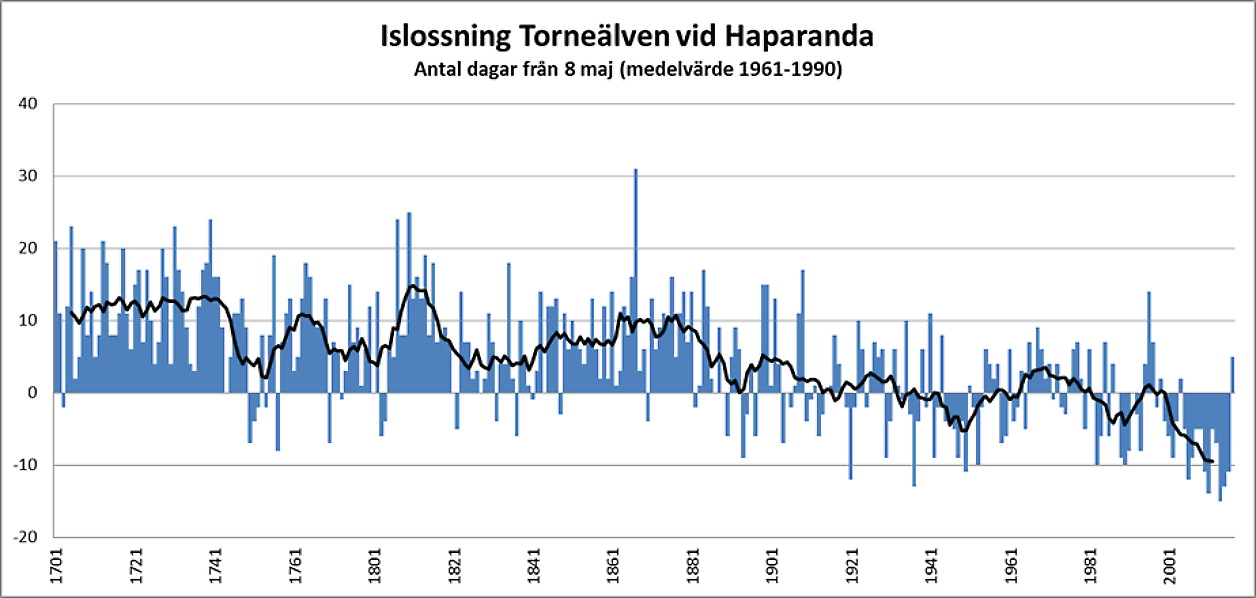Guest Post by Willis Eschenbach [See updates at the end]
In the continental US, most of the rivers run east, west, or south. But in the Yukon and in Alaska, a number of them run north. The Yukon is a most curious river. The source of the Yukon in Lake Bennett in the Yukon Territory is only about forty miles (65 km) from the ocean … but instead of taking the direct route, it flows a total of almost 2000 miles (3200 km) before it finally gets to the ocean near Nome, Alaska.
Along the way, past Fairbanks in Alaska, the Yukon is joined by one of its many tributaries, the Tanana River. Like the Yukon, the Tanana also flows mostly north.

You can see the Tanana River noted in blue just to the left of Fairbanks.
And why is it significant that the Yukon and Tanana rivers run north? Well, it leads to a curious condition in the springtime. Over the winter, of course, the rivers tend to freeze up solid. In the spring, the south end of both rivers tend to thaw first … and that makes the breaking up of the ice a sudden event, with the mass of water surging downriver and clearing out the ice as it goes.
This is all of interest to climateers because the nights in the far north are so long. Why is the length of the nights relevant? Well, people get bored when it’s dark most of the time, and back in the day there was no TV up north … and as a result, more than a century ago people took to betting on the exact date and time that the rivers would experience “ice-out”, as it is called. Hey, you gotta do something to keep the megrims away …
So simply because humans like to bet, we have a hundred years or so of records of the exact dates of ice out for both the Yukon and the Tanana Rivers. The betting is a pool, with everyone putting in money, and the winner(s) take all. The betting on the Tanana River ice-out is called the Nenana Ice Classic, after the town where the betting takes place. This year the pool on the Nenana Ice Classic is just under a quarter of a megabuck … serious money.
How close to ice-out is the Tanana River? The precise ice-out date and time is determined by putting a tripod out on the rivers and connecting the top of the tripod by a cable to a clock in a tower on shore. Here’s a photo of the tripod and the tower I took when I visited the Tanana River a few years ago … obviously in the summer.

The Yukon river tripod is erected on the ice in the river near to Dawson City, Yukon Territory, and the Tanana River tripod is erected on the ice near to Nenana, Alaska.
And all of this is of interest right now because today the Tanana River is just about, nearly, almost, really close to, right on the edge of, ice-out.
As of this morning, here’s the situation on the Tanana River:

As you can see, the Nenana Ice Classic tripod out on the river ice has tilted precariously … but it hasn’t moved enough yet to stop the clock. Amazingly, I do believe that this is likely the very first photographic evidence of one of those famous “climate tipping points” that we all get warned about … but I digress.
So the ice in Nenana will likely go out today (May 1st) or tomorrow. And on the Yukon? Predictions are that the Yukon ice-out will occur on May 4 this year.
And what does the record of the ice-out dates for the two rivers show? Here you go.

This is a most fascinating record because it is totally unaffected by all of the things that bedevil temperature measurements—changes in station locations, changes in instrumentation, changes in time of observation, urban heat islands, trees growing around the thermometers, parking lots, increases in airport traffic near the station, none of these variables affect the ice-out dates in any meaningful way. It is a pure record of cumulative weather conditions each spring.
You can see the peak of the temperatures about 1940, and the drop in temperature to about 1965. From there, temperatures rise until the 1990s, followed by the infamous plateau in warming up to the present. In fact, it looks a lot like the early GISS global average temperature records, before the drop after the 1940s got mostly erased from the record.
Now, there has been a lot of recent discussion here on WUWT about putative solar effects on the climate. So I thought I’d make a comparison of the temperature as represented by the ice-out dates, and the solar activity as represented by the sunspots.

I’m sure you can see the problem. The solar activity has generally been decreasing since the peak in about 1958 … but the Arctic has been generally warming since about 1965 up to 1995 or so, and it’s been basically flat since then. Decreasing sunspot activity … increasing temperatures … not a good look for any purported solar influence on climate.
This makes it very hard to argue that sunspot-related variations in solar activity have much effect on arctic temperatures. And this is true even if you believe that there is a decade or so of lag between solar activity and temperature. A lag of a decade is equivalent to moving the black line to the right an amount equal to one of the dotted lines … and that doesn’t improve the fit in any way.
This is another of the many datasets that I’ve looked at that have not shown any sunspot-related signal. Do all of my negative findings show that the sunspot variations don’t affect surface climate datasets? Nope. You can’t prove a negative. It’s just one more in the long list of datasets that do not show any such sunspot-related signal.
Regards to all, spring is here, the ice is melting … well, most places it’s melting …
[UPDATE] My thanks to Dave Burton in the comments, who noted that you can click here for the latest webcam picture …
[UPDATE 2] Here’s how the alarmist Gavin Schmidt, serial failed doomcaster, spins the Nenana data on Twitter …
Gavin Schmidt @ClimateOfGavin · 9h This year will be v. close to trend.
w.
PS—When you comment on someone’s words, please quote the exact words you are referring to. Misunderstandings are the bane of the intarwebs, and if you quote the exact words we can all understand just what it is that you are discussing.












